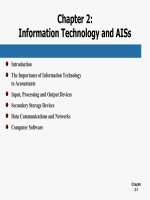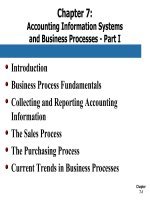Accounting information systems 12th SIMKIN and norman chapter 04
Bạn đang xem bản rút gọn của tài liệu. Xem và tải ngay bản đầy đủ của tài liệu tại đây (616.49 KB, 45 trang )
Chapter 4:
Organizing and Manipulating the Data in
Databases
Introduction
Creating Database Tables in Microsoft Access
Entering Data In Database Tables
Extracting Data From Databases: Data Manipulation Languages
Recent Database Advances and Data Warehouses
Chapter
4-1
Creating Database
Tables in Microsoft Access
Database Management Systems
An Introduction to Microsoft Access
Creating Database Tables
Creating Relationships
Chapter
4-2
Database Management
Systems
Overview
Not a database
Separate software system
Functions
Enables users to utilize database information more efficiently
Examples
Access, Alpha 5, dQuery, Lotus Approach
Chapter
4-3
Introduction to Microsoft
Access
A popular relational database
Used by many businesses and individuals
Used for small database applications
Chapter
4-4
Microsoft Access – Opening
Screen
Chapter
4-5
Creating Database Tables –
Defining Record Format
Field Name
Names assigned to the data fields
Data Type
Specified for each data field
Identifies how to store the data – field properties
Description
Optional field
Defines record structures
Chapter
4-6
Creating Database Tables –
Opening Screen
Chapter
4-7
Creating Database Tables –
Record Format
Chapter
4-8
Creating Relationships
Purpose
Link tables together
Enable users to create multi-table reports
Steps in Creating Relationships
Select tables
Link the tables
Chapter
4-9
Creating Database
Relationships – Linking Tables
Chapter
4-10
Creating Relationships –
Multitable Relationships
Chapter
4-11
Creating Records
Utilize datasheet view to input data
Chapter
4-12
Ensuring Valid and Accurate
Data Entry
Data Definition Language (DDL)
Enables users to define record structure
Define individual fields of each record
Chapter
4-13
Tools for Data Validation
Proper Data Types for Fields
Input Masks
Limit data to specific formats
Default Values
Data fields of new records
Chapter
4-14
Tools for Data Validation
Drop-Down Lists
Validation Rules
Create rules than limit range of values that may be entered
Referential Integrity
Deleting of information disallowed when it would disrupt references
Chapter
4-15
Drop-Down List Example
Chapter
4-16
Validation Rule Example
Chapter
4-17
Creating Referential Integrity
Chapter
4-18
Study Break #1
All of the following are examples of DBMSs except:
A. Access
B. Oracle
C. DB2
D. SQL
Chapter
4-19
Study Break #1 - Answer
All of the following are examples of DBMSs except:
A. Access
B. Oracle
C. DB2
D. SQL
Chapter
4-20
Study Break #2
An example of a validation rule is:
A. An input value must be an integer
B. An input value must also have a default value
C. An input value must be between 0 and 40
D. You cannot delete parent records that have child records
associated with them
Chapter
4-21
Study Break #2 - Answer
An example of a validation rule is:
A. An input value must be an integer
B. An input value must also have a default value
C. An input value must be between 0 and 40
D. You cannot delete parent records that have child records
associated with them
Chapter
4-22
Tips for Creating
Database Tables and Records
Design first
Create
tables and records last
Name tables systematically
Use conventional tbl prefixes
Use mnemonic names for data fields
Assign correct data types to data fields
Chapter
4-23
Tips for Creating
Database Tables and Records
Data fields that link tables must be the same
data type
Limit the size of text data fields to reasonable
lengths
Use input masks
Chapter
4-24
Extracting Data From
Databases
Schema
All information in a database
All relationships of the tables
Map of entire database
Subschema
Subset of the schema
Chapter
4-25









